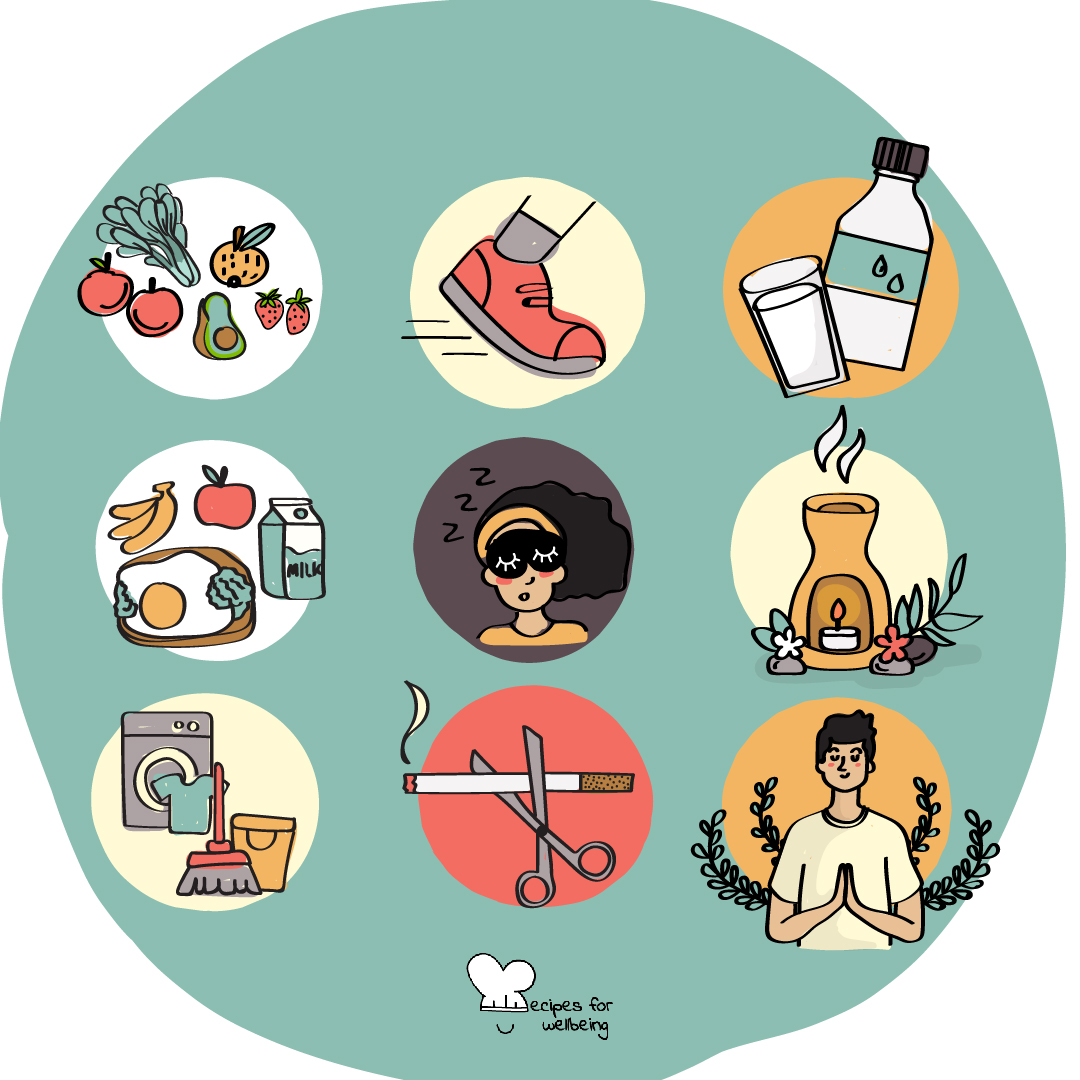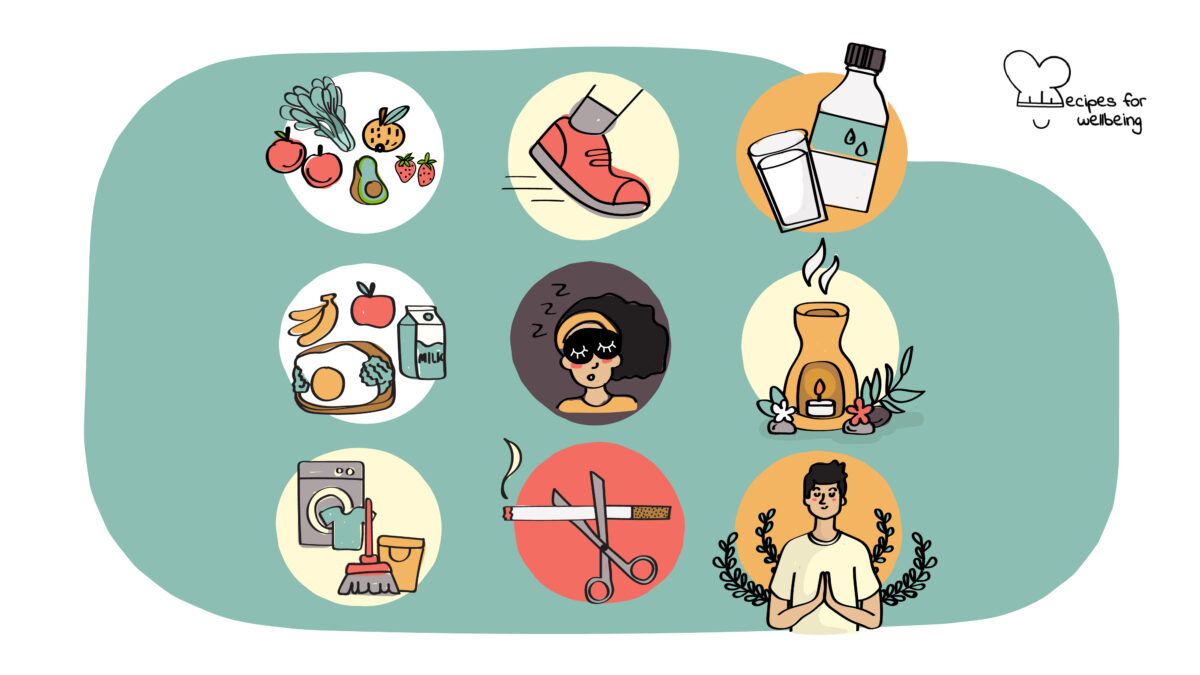
9 habits for a healthy lifestyle
Take care of your body. It’s the only place you have to live in. ―John Rohn
 Serves: 1 person
Serves: 1 person
 Difficulty: Medium
Difficulty: Medium
 Total time: Ongoing
Total time: Ongoing
 Ingredients: Depends according to the tips
Ingredients: Depends according to the tips
 Wholebeing Domains: Awareness, Discomfortability, Rest, Ritualising
Wholebeing Domains: Awareness, Discomfortability, Rest, Ritualising
 Wholebeing Skills: Exercising, Mind-body-connection, Mindfulness, Movement, Self-regulation, Sleep
Wholebeing Skills: Exercising, Mind-body-connection, Mindfulness, Movement, Self-regulation, Sleep

9 habits for a healthy lifestyle
 Description
Description
Tips for living a healthy life.
Taking good care of your body is not a passing fad; it is an essential part of ensuring a balanced life. Cultivating healthy habits brings positive, lasting effects that reach far into the future; by contrast, trying to get ahead with shortcuts may create anxiety and may result in more serious physical ailments down the road.
In today’s fast-paced world, maintaining a healthy lifestyle may seem like an impossible task. But if you focus on changing small habits in your daily routine, you will benefit from huge rewards down the line. The following activity shares 9 habits to maintain a healthy lifestyle and it has been kindly donated by Alison Lawson, an entrepreneur and a freelance writer.
If you need help in assessing your habits, check out our recipe “The habits scorecard”. Also, if you want to track your progress, use our recipe “Habit tracker”.
 Steps
Steps
Step 1 – Consume healthy food
Eating healthily can do wonders for your wellbeing! A balanced diet with sufficient proteins, fibres, and multivitamins will provide you with a sound foundation of good health. Make sure to include different fruits and veggies in your cuisine as they are rich in essential nutrients. If you eat animal products, make sure to consume them in moderation, without exceeding in quantity or frequency. We strongly recommend working with a food nutritionist or dietician to craft a balanced and nutritious diet around your unique needs and body configuration.
Small tip: Chew each bite 20–30 times before swallowing because this helps break down complex molecules into simpler ones that facilitate digestion. If you don’t think this is possible, try out the “Mindful eating” or “Raisin meditation” recipes to slowly savour what you are eating.
Step 2 – Exercise your body
Movement is a key part of living healthy! Regular exercise can improve your lifestyle, bolster bone and muscle strength, help to maintain weight, and even reduce the risk of illnesses like diabetes, heart disease, or stroke.
Doctors recommend 30-minute of brisk walking 5–6 times a week as an easy way to reap the benefits of physical activity. If you are looking for some inspiration, check out the following recipes to engage your body: “Ecstatic dance”, “Gentle morning flow”, “Immune sequence (morning)”, “Morning yoga routine”, “Sun salutation”, “Walking meditation”, and “Yoga4Peace”.
Step 3 – Drink enough water
To keep your body feeling at its best, you need to drink water! Not only is water essential for life – it is also responsible for keeping every organ and tissue in your body healthy. If you struggle to keep hydrated, keep a bottle of water handy and put regular alarms throughout the day to remind you to take a sip.
Step 4 – Start your day with breakfast
Starting your day with a healthy and balanced breakfast is the key to jump starting metabolism as well as maintaining overall health. Make sure to incorporate fibres, vitamins, and minerals into your morning meal while cutting down on fat and carbs to ensure sustained energy throughout the day.
Step 5 – Get enough rest
Without adequate sleep, your body and mind can easily run out of fuel. Sleep deprivation symptoms such as drowsiness, fatigue, loss of concentration… may slowly derail you from a healthy lifestyle if ignored for too long. How much sleep is adequate? Doctors recommend around 7–8 hours each night to prevent the ill effects caused by not getting enough sleep.
If you have trouble sleeping well throughout the night, here are some recipes to support your sleep: “Body scan meditation for sleep”, “CBT strategies to help you sleep”, “Narrative reframing for sleep”, “PowerPoint for a peaceful sleep”, and “Sleeping well”.
Step 6 – Reduce the stress
Stress can take a serious toll on physical and mental wellbeing. To protect your long-term health, it is important to learn how to relieve stress from your daily life – whether through yoga routines or meditation techniques. Check out the following recipes to help you manage your stress: “Box breathing”, “Managing stress”, and “Stress diary”. And if you would like to change your perspective around stress, we invite you to give this a try: “Befriending stress”.
Step 7 – Maintain a healthy hygiene
A little daily care can make a world of difference! Maintaining good hygiene has a tremendous potential for enhancing your health and social life. You can turn the simple action of brushing your teeth into a small mindful moment.
Step 8 – Quit smoking
Quitting smoking can have a dramatic impact on your health. Studies have found that, after quitting, you can reduce the risk of developing heart disease and stroke by as much as 50% whilst increasing significantly your life expectancy. Smoking is one of several unhealthy habits that keep you prisoner of addiction cycles. Breaking up such addictive cycles can enhance your wellbeing. We know this is not an easy process, so we advise you to try our recipe “The desire to change” for step-by-step guidance.
Step 9 – Take care of your mental health
Cultivating mental health is important for overall wellbeing and happiness. Mental health includes our emotional, psychological, and social wellbeing, and it can affect how we think, feel, and act. Simple activities like eating a healthy and balanced diet (habit #1), getting regular physical exercise (habit #2), sleeping enough (habit #5), and keeping an eye on your stress levels (habit #6) can all contribute to your mental health. Additionally, other activities such as connecting with others on a regular basis and practising mindfulness meditation can boost your mental health.
If you are lacking inspiration, here are some recipes we invite you to try: “4–7–8 breathing technique”, “Body scan meditation”, “Catharsis through clay”, “Colourful confusions”, “Cultivating presence”, “Cycle of emotions”, and “Empathic conversations”.


 Arabic
Arabic Chinese (Simplified)
Chinese (Simplified) Dutch
Dutch English
English French
French German
German Italian
Italian Portuguese
Portuguese Russian
Russian Spanish
Spanish